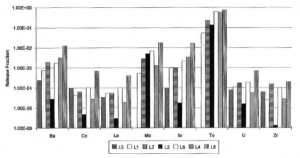ACE試験
ナビゲーションに移動
検索に移動
概要


1998-1991年にアメリカANLで実施されたMCCI試験[1][3]。MCCI中のFP挙動及び解析モデル検証のための熱水力挙動取得のために実施された。 UO2-ZrO2とFP(BaO, La2O3, SrO, CeO2, MoO2, SnTe, ZrTe2, Ru)、制御棒材(B4C,Ag/In)が使用され、これらの混合物を直接電気加熱で溶融し、コンクリートと反応させた。
溶融デブリ - コンクリート反応挙動
- 各条件でのコンクリート侵食速度はSURC試験と同程度の1~4mm/minであった。
溶融デブリ - コンクリート反応挙動
- 金属成分存在下ではH2O、CO2が減少し、H2、COの発生が増加。
- ガスの25%~50%はコンクリートを透過し、外部に放出されていることが報告されている。
- エアロゾル成分はコンクリートが分解したSiO(g)が多くを占め、Te以外のFPの放出は少ない結果となった。
関連項目
参考文献
- ↑ 1.0 1.1 D.H. Thompson, J.K. Fink, D.R. Armstrong, B.W. Spencer, B.R. Sehgal, "Thermal-Hydraulic Aspects of the Large-Scale MCCI Tests in the ACE Program", 2nd CSNI Specialist Meeting on Core Debris-Concrete Interactions. Karlsrühe, Germany(1992). https://inis.iaea.org/search/search.aspx?orig_q=RN:40026310
- ↑ OECD and Nuclear Energy Agency, "State-of-the-Art Report on Molten Corium Concrete Interaction and Ex-Vessel Molten Core Coolability", OECD Publishing, ISSN 1990-1577 (2017). https://doi.org/10.1787/19901577
- ↑ J.K. Fink, D.H. Thompson, D.R. Armstrong, B.W. Spencer, B.R. Sehgal, "Aerosol and Melt Chemistry in the ACE Molten Core-Concrete Interaction Experiments", High Temperature and Materials Science, 33, 1, 51-76 (1995). https://ci.nii.ac.jp/ncid/AA11037008